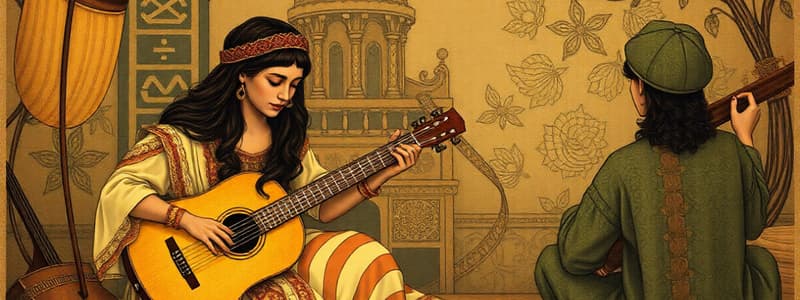Podcast
Questions and Answers
What is the significance of the toe-bone whistles and the Divje Babe flute in the context of early music?
What is the significance of the toe-bone whistles and the Divje Babe flute in the context of early music?
- They were exclusively used in shamanistic rituals.
- They were primarily used for hunting and gathering.
- They demonstrate the advanced metallurgy skills of early humans.
- They represent some of the earliest forms of musical instruments. (correct)
How does the example of Simon Thorne's work contribute to our understanding of early music?
How does the example of Simon Thorne's work contribute to our understanding of early music?
- It suggests how Neanderthals might have used voices and tools to produce sounds. (correct)
- It proves that Neanderthals had complex musical notation.
- It replicates the exact melodies used in Neanderthal rituals.
- It confirms that Neanderthals preferred rhythmic clapping over melodic instruments.
What is the primary connection between early music and the natural world, according to the text?
What is the primary connection between early music and the natural world, according to the text?
- Early humans used music solely to mimic animal sounds for hunting.
- Natural sounds, like animals and water, were sources of inspiration for early music. (correct)
- Music served as a way to document weather patterns and seasonal changes.
- Early musical instruments were constructed primarily from plant-based materials.
What is the role of clapping in the musical traditions of the Solomon Islands?
What is the role of clapping in the musical traditions of the Solomon Islands?
How did shamans in the Altai Republic use sound in their practices?
How did shamans in the Altai Republic use sound in their practices?
What is the main idea conveyed by the text's suggestion to listen to everyday sounds?
What is the main idea conveyed by the text's suggestion to listen to everyday sounds?
According to the passage, what were some of the primary purposes of early music?
According to the passage, what were some of the primary purposes of early music?
Flashcards
Early Music
Early Music
Music inspired by natural sounds and used for communication and celebration.
Neanderthal Sounds
Neanderthal Sounds
Reconstructed sounds that Neanderthals may have created using vocals and tools.
Toe-Bone Whistle
Toe-Bone Whistle
Ancient whistles made from animal toe bones, dated to 40,000 BCE.
Clapping in Culture
Clapping in Culture
Signup and view all the flashcards
Shamanic Sounds
Shamanic Sounds
Signup and view all the flashcards
Divje Babe Flute
Divje Babe Flute
Signup and view all the flashcards
Listening Skills
Listening Skills
Signup and view all the flashcards
Study Notes
Early Human Music
- Early humans were inspired by natural sounds like animals, water, and tools
- Music was used for communication, entertainment, and celebration
- Music traditions were passed down orally through generations
- Indigenous communities' present-day musical traditions are continuations of ancient ones
Neanderthal Music
- In 2009, a Welsh composer, Simon Thorne, worked with scientists to reconstruct Neanderthal sounds
- Neanderthals likely used their voices and tools to create music
Ancient Musical Instruments
- Toe-bone whistles (40,000 BCE, France) were made from animal bones
- Divje Babe flute (40,000 BCE, Slovenia): An ancient flute, one of the oldest surviving musical instruments, was made of an animal bone
Cultural Music Traditions
- Clapping, singing, hand gestures, and dance were important parts of music in Solomon Islands
- Shamans in the Altai Republic, Russia, used music to communicate with spirits while in a trance-like state
Studying That Suits You
Use AI to generate personalized quizzes and flashcards to suit your learning preferences.




